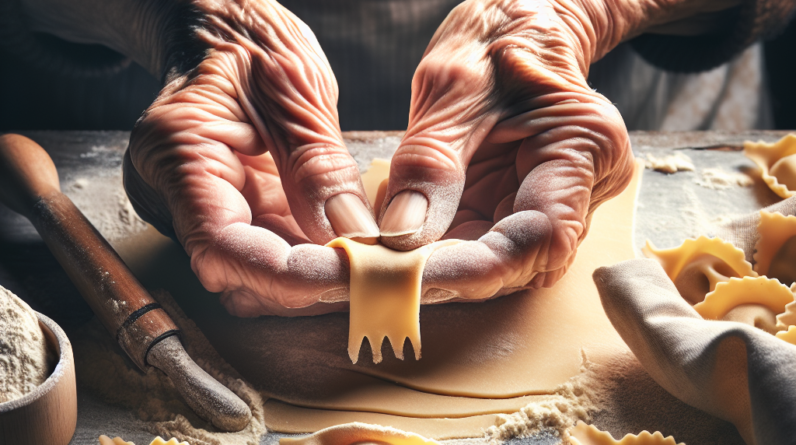Italian bread is a culinary treasure that has a rich and fascinating history. From the humble beginnings in ancient Rome to the staple presence on every Italian dinner table, this bread has played a significant role in Italian cuisine for centuries. Its importance in meals cannot be understated, as it serves as the perfect accompaniment to hearty pasta dishes, as well as a vessel for creating delicious sandwiches. Join us as we explore the intriguing journey of Italian bread, uncovering its origins, traditional baking methods, and its undeniable impact on the gastronomic heritage of Italy.
1. Origin of Italian Bread
Italian bread has a rich and fascinating history that dates back to ancient times. Its origins can be traced to the cultivation of grains in Italy, the influence of ancient Rome, and the introduction of bread-making techniques from the Middle East.
1.1 Ancient Grain Cultivation in Italy
Grains have been cultivated in Italy for thousands of years, with the Etruscans and Romans being early pioneers in the art of agriculture. Wheat, in particular, was grown extensively in the region and became a staple crop for making bread. The fertile soil and favorable climate of Italy provided ideal conditions for cultivating high-quality grains, which ultimately played a significant role in the development of Italian bread.
1.2 Italian Bread in Ancient Rome
Ancient Rome greatly contributed to the evolution of Italian bread. Romans were early adopters of advanced baking techniques, such as milling wheat to produce fine flour and using ovens for baking bread. They even had specialized bakers, known as “pistor,” who were highly skilled in the craft. Bread became a dietary staple for the Romans, serving as a primary source of sustenance for both the wealthy and the common people.
1.3 Influence of Middle Eastern Breads
Italian bread also owes its heritage to the influence of Middle Eastern cultures. The trade routes, known as the Silk Road, facilitated the exchange of goods and ideas between different civilizations, including their culinary traditions. Middle Eastern bread-making techniques, particularly the use of sourdough starters and slow fermentation, were introduced to Italy and integrated into the local bread-making practices. This cross-cultural exchange served as a catalyst for further advancements in Italian bread production.
2. Types of Italian Bread
Italy boasts a diverse array of bread varieties, each with its own unique characteristics, flavors, and purposes. From rustic loaves to delicate pastries, Italian bread offers something for every palate. Here are some of the most beloved types of Italian bread:
2.1 Pane Casereccio
Pane Casereccio, or “homemade bread,” is a classic staple in Italian households. This rustic loaf is characterized by its rustic appearance, crusty exterior, and an airy, chewy crumb. Made with simple ingredients like flour, water, yeast, and salt, Pane Casereccio showcases the essence of traditional Italian bread-making.
2.2 Ciabatta
Ciabatta, meaning “slipper” in Italian due to its elongated shape, is a versatile and widely popular bread. With its light and airy texture, large air holes, and soft crust, Ciabatta is perfect for sandwiches or dipping in olive oil. Its origins can be traced back to the 1980s, when a baker in Verona developed the recipe as a response to the popularity of French baguettes.
2.3 Focaccia
Focaccia is a flat, oven-baked bread that originated in Genoa, in the Liguria region of Italy. Its name is derived from the Latin word “focus,” meaning “hearth” or “fireplace,” as it was traditionally baked on the hearth. Focaccia is known for its fluffy texture, dimpled surface, and aromatic toppings, such as rosemary, olive oil, and sea salt. It can be enjoyed on its own, used as a base for sandwiches, or served alongside soups and stews.
2.4 Grissini
Grissini, also known as breadsticks, are slender and crispy sticks of bread that are popular throughout Italy. Originating in Turin, Grissini were originally created in the 17th century as a solution for a sickly young duke who struggled to consume regular bread. The thin and crunchy texture of Grissini made them easier to eat, and they soon became a beloved snack and accompaniment to antipasti, cheese, and cured meats.
2.5 Panettone
Panettone is a sweet, enriched bread traditionally consumed during festive seasons, particularly Christmas and New Year’s celebrations. Originating in Milan, Panettone is characterized by its tall, domed shape, light and fluffy texture, and a rich combination of ingredients like dried fruits, nuts, and citrus zest. Its preparation is a labor of love that involves multiple fermentation stages, resulting in a delightfully aromatic and flavorful bread.

3. Traditional Bread-Making Techniques
Italian bread is renowned for its exceptional quality and taste, thanks to the meticulous traditional bread-making techniques that have been handed down through generations. These techniques emphasize the role of yeast and sourdough starters, the importance of slow fermentation, and the use of traditional baking methods.
3.1 The Role of Yeast and Sourdough Starter
Yeast plays a crucial role in Italian bread-making, providing the leavening agent that creates the desired texture and structure. While commercial yeast is commonly used in modern bread production, many traditional Italian breads rely on sourdough starters. A sourdough starter is a naturally fermented mixture of flour and water that contains wild yeast and beneficial bacteria. It adds depth of flavor and complexity to the bread, resulting in a distinctive taste.
3.2 Importance of Slow Fermentation
Italian bread-making takes a patient approach, favoring slow fermentation to develop flavors and enhance the bread’s digestibility. The dough is allowed to rest and ferment for extended periods, often overnight or even longer, to allow the yeast or sourdough cultures to ferment and metabolize the sugars in the dough. This slow fermentation process not only improves the texture and flavor of the bread but also improves its nutritional qualities, making it easier to digest.
3.3 Use of Traditional Baking Methods
Traditional Italian bread is often baked in wood-fired ovens, which impart a unique smoky flavor and ensure even heat distribution. The high heat of the oven creates a perfectly crispy crust while maintaining a soft and airy interior. Bakers also employ techniques such as spraying water on the dough before baking to create steam, which contributes to a beautiful crust and moist crumb. These traditional baking methods are essential in achieving the characteristic qualities of Italian bread.
4. Role of Bread in Italian Cuisine
Bread holds a significant place in Italian cuisine, serving both as a staple ingredient and a versatile accompaniment to various dishes. Its importance can be seen in the traditional recipes, appetizers, salads, and even popular sayings regarding its presence in Italian culture.
4.1 Staple Ingredient in Italian Diet
Bread has long been a fundamental part of the Italian diet, serving as a reliable source of sustenance for centuries. It provides a vital source of carbohydrates and nutrients, making it an essential component of every meal. Whether it’s paired with cheese, used for soaking up sauces, or as a base for sandwiches, bread is a constant presence on Italian dining tables.
4.2 Bread as an Appetizer
In Italy, bread often takes center stage even before the main course. Various regional traditions showcase the diverse ways bread is served as an appetizer. For example, in Tuscany, a traditional dish called “fettunta” features grilled bread rubbed with garlic and drizzled with olive oil. In Apulia, “taralli” are small, crunchy bread snacks with various flavors such as fennel or black pepper. These appetizers highlight the importance of bread as a prelude to a delicious meal.
4.3 Panzanella: A Bread-Based Salad
Panzanella is a classic Tuscan salad that showcases the resourcefulness of Italian cuisine. This refreshing dish combines stale bread, tomatoes, cucumbers, onions, basil, and a light vinaigrette. The bread soaks up the vibrant flavors of the vegetables and dressing, creating a harmonious blend of textures and tastes. Panzanella highlights the role of bread as a versatile ingredient that can be transformed into a hearty and satisfying dish.
4.4 Bruschetta and Crostini
Bruschetta and crostini are beloved Italian appetizers that showcase the simplicity and versatility of bread. Bruschetta consists of grilled bread rubbed with garlic, topped with fresh tomatoes, basil, and drizzled with olive oil, while crostini are small toasted bread slices topped with various spreads, such as pâté, cheese, or vegetables. Both dishes highlight the crisp texture of bread, serving as a platform to showcase the vibrant flavors of the toppings.
4.5 Bread as a Complement to Pasta and Soups
Bread also plays an essential role in rounding out the flavors of Italian pasta and soup dishes. From classic dishes like spaghetti with garlic and oil to heartwarming minestrone soup, bread is often served alongside to scoop up every last drop of sauce or broth. Its ability to add substance and texture to these dishes enhances the overall dining experience. Italians understand the importance of bread in enhancing the flavors and savoring every bite.

5. Symbolism and Cultural Significance
Bread holds a deep symbolic and cultural significance in Italian society, intertwined with religious traditions, communal sharing, and the wisdom of proverbs and sayings.
5.1 Bread in Italian Religious Traditions
In the predominantly Catholic country of Italy, bread plays a prominent role in religious rituals. The sacrament of the Eucharist, where bread is consecrated and believed to transform into the body of Christ, is an integral part of Catholic Mass. The act of sharing bread during religious services emphasizes unity, community, and the shared spiritual journey. Bread represents sustenance not only for the body but also for the soul.
5.2 Bread as a Symbol of Communion and Sharing
Italian culture places great importance on communal meals and sharing with others. Bread embodies this spirit of togetherness and hospitality. In many Italian households, breaking bread together is a cherished tradition, symbolizing friendship, generosity, and acceptance. The act of offering bread to guests is a gesture of warmth and welcoming, bridging the gap between strangers and forging connections.
5.3 Bread in Italian Proverbs and Sayings
Italian culture is rich in proverbs and sayings that showcase the significance of bread in everyday life. Phrases like “Pane al pane, vino al vino” (Bread to bread, wine to wine) or “Senza pane tutti i giorni, tutti i torti sembrano dire” (Without bread every day, all wrongs seem to be said) emphasize the importance of bread as a basic necessity and a symbol of life’s sustenance and satisfaction. These sayings remind us of the essential role bread plays in our lives and the wisdom passed down through generations.
6. Evolution of Italian Bread in Modern Times
Over the centuries, Italian bread has experienced various transformations, influenced by factors such as industrialization, artistic revival, innovative trends, and the diversity of regional specialties.
6.1 Industrialization and Commercialization
With the advent of industrialization, bread production shifted from small-scale artisanal bakeries to larger factories. Mass production techniques increased efficiency and accessibility, but also resulted in the loss of traditional flavors and craftsmanship. Commercial bread aimed to meet the demands of a growing population, often sacrificing quality for convenience.
6.2 Revival of Artisan Bread
In response to the industrialization of bread, there has been a resurgence of artisanal bread-making in recent decades. Artisan bakers have rekindled traditional baking methods, prioritizing natural ingredients, longer fermentation times, and skilled craftsmanship. This revival focuses on restoring the authentic flavors and textures that were once synonymous with Italian bread.
6.3 Bread Innovations and Reinventions
As culinary trends evolve, so does Italian bread. Modern chefs and bakers have pushed boundaries by experimenting with new ingredients, flavor combinations, and techniques. From incorporating ancient grains for added nutritional value to creating gluten-free alternatives, innovations have expanded the possibilities of Italian bread. These adaptations create a bridge between tradition and modernity, appealing to diverse tastes and dietary preferences.
6.4 Regional Bread Specialties
Italy’s regional diversity is reflected in its diverse bread specialties, each region offering its unique creations and traditions. From Altamura bread in Puglia to Pane Carasau in Sardinia, these regional bread varieties showcase the distinct culinary heritage of different areas. Amidst globalization, regional bread specialties play a crucial role in preserving local cuisines and captivating the taste buds of both Italians and visitors alike.

7. Global Influence and Adaptation
Italian bread has gained global recognition and has been widely embraced in different parts of the world. Its adaptability and versatility have allowed it to be seamlessly integrated into various international cuisines.
7.1 Italian Bread Around the World
Italian immigrants have carried their bread-making traditions to different corners of the globe, sharing their expertise and recipes. Italian bread, with its signature flavors and textures, has become a staple in many countries, where it is enjoyed both for its culinary excellence and its connection to Italian culture. You can find panini, bruschetta, and countless other Italian bread-based dishes on menus worldwide, showcasing the widespread love for this culinary icon.
7.2 Incorporation in International Cuisines
Italian bread has also become a source of inspiration for chefs and bakers worldwide. Its techniques, such as slow fermentation and the use of sourdough starters, have been adopted and adapted to suit different baking traditions. Italian bread’s influence can be seen in artisanal bakeries and restaurants across the globe, where its flavors and methods have been incorporated into various international cuisines. This fusion of flavors and techniques highlights the universal appeal and adaptability of Italian bread.
8. Preserving Italian Bread Heritage
Preserving the heritage and traditional recipes of Italian bread is essential to protecting its authenticity and cultural value. Efforts have been made to safeguard Italian bread’s legacy through designations and initiatives.
8.1 Protected Designation of Origin (PDO) and Traditional Specialty Guaranteed (TSG) Labels
The European Union (EU) has implemented protections to ensure the authenticity of traditional Italian bread. Through designations like Protected Designation of Origin (PDO) and Traditional Specialty Guaranteed (TSG), specific bread varieties are safeguarded against imitation or misrepresentation. These labels provide consumers with assurance regarding the provenance and adherence to traditional production methods, supporting the preservation of Italian bread heritage.
8.2 Efforts to Preserve Traditional Italian Bread Recipes
Various organizations, institutions, and passionate individuals in Italy work tirelessly to document and archive traditional Italian bread recipes. These efforts involve collecting recipes from older generations, conducting research, and promoting the continued practice of artisanal bread-making techniques. By preserving these valuable recipes, generations to come can experience the authentic flavors and techniques that define traditional Italian bread.
9. Challenges and Future Trends
Although Italian bread has withstood the test of time, it faces several challenges and must adapt to changing consumer preferences and environmental concerns.
9.1 Modern Lifestyle and Consumption Patterns
Busy modern lifestyles have shifted appetites towards convenience and speed, posing challenges for traditional bread artisans. Convenience-focused options such as pre-sliced bread and quick bread mixes have become popular, often at the expense of traditional bread-making techniques and flavors. This changing consumer landscape presents a challenge for preserving the art of Italian bread-making.
9.2 Innovations in Bread Production
To meet the demands of modern consumers, bakers must embrace innovative technologies in bread production. These technologies could enhance efficiency, maintain consistent quality, and prolong shelf life without compromising flavor and nutrition. Balancing tradition and innovation will be crucial in ensuring the future of Italian bread.
9.3 Sustainability and Locally Sourced Ingredients
As sustainability becomes increasingly important, bakers are exploring ways to source local ingredients, support organic farming practices, and reduce food waste. Regional wheat varieties, heirloom grains, and ancient cereals are gaining attention for their unique flavors and environmental benefits. Embracing sustainable practices and locally sourced ingredients will be essential to future-proofing Italian bread.
9.4 Cultural Heritage Preservation in Changing Times
Preserving the cultural heritage of Italian bread in times of rapid globalization is a continuing challenge. As culinary landscapes evolve and tastes diversify, maintaining the traditions, stories, and craftsmanship of Italian bread becomes even more critical. By raising awareness of the cultural significance and distinctive qualities of Italian bread, we can ensure its enduring presence.
10. Conclusion
Italian bread stands as a cultural icon, deeply embedded in the fabric of Italian cuisine and society. Its origins in ancient grain cultivation, influence from Middle Eastern bread-making techniques, and rich culinary traditions have shaped Italian bread into the beloved staple it is today. From rustic loaves to delicate pastries, Italian bread encompasses a vast array of flavors, textures, and techniques.
Italian bread’s role extends beyond the dining table, symbolizing communion, sharing, and cultural wisdom. It has spread its influence globally, becoming a beloved staple around the world. Efforts to preserve traditional recipes, designations of origin labels, and the promotion of artisanal craftsmanship are essential in safeguarding Italian bread heritage.
As we navigate the challenges of modern lifestyles and changing environmental concerns, the future of Italian bread relies on the balance between tradition and innovation. By embracing sustainable practices, locally sourced ingredients, and preserving cultural heritage, we can ensure that Italian bread remains a symbol of craftsmanship, flavor, and togetherness for generations to come. The continued importance of Italian bread in Italian cuisine is a testament to its enduring legacy and the deep appreciation for this culinary treasure.










